The Pakistani rupee has become the weakest currency in South Asia, with the Sri Lankan currency overtake it. The rupee recently reached its weakest level against the US dollar and is at risk of further decline. Pakistan is facing economic and political crises, with warnings of a possible default. Business leaders are concerned about the impact of default risks on the business environment, opposing super tax and income tax on their profits. The country is expecting a $6.5 billion bailout package from the IMF, which is critical to avoid defaulting on external payment obligations.
Pakistan’s foreign exchange reserves are dangerously low, with declining reserves and a large quantity of foreign currency needed to cover import costs and pay off foreign debt. Over 20,000 letter of credits are pending for clearance in State Bank of Pakistan due to a shortage of dollars. Chinese and Malaysian firms are demanding advance payments from Pakistani traders as they are not trusting Pakistan’s economic system.
If Pakistan defaults, the country will lose access to international markets, trading and foreign bonds. It will also face trade restrictions, hyperinflation, and all commercial banks will face defaults. The GDP of Pakistan will contract, and there will be a steep devaluation of Pakistani rupee. Islamabad may also face lawsuits, sanctions, and a downgrade in its rating.

